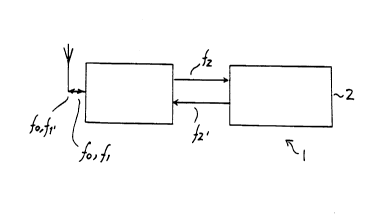Note : Les revendications sont présentées dans la langue officielle dans laquelle elles ont été soumises.
Claims:
1. Method for individual identification using electronic interrogation by transmis-
sion and reception of signals of a certain frequancy from a transmitter/receiver unit,
wherein an identification chip (1), comprising a inactive code carrier (2), such as a
SAW-component, and an antenna (4), where the antenna (4) receives the transmitted
signal which then is applied to the code carrier (2), and a signal, superimposed with
the individual code of the code carrier, is reflected from the code carrier (2),characterized by comprising the following steps:
transmission, from the transmitter/receiver unit, of a first and a second signal(f0, f1) of different frequencies,
mixing the two signals (f0, f1) after reception thereof by the antenna (4), to provide
a third signal (f2), having a frequency which is a combination of the frequencies of
the first and the second signals (f0, f1),
applying the third signal (f2) to the code carrier (2), so that the code carrier ref-
lects a first coded signal (f2.) having a frequency corresponding to the frequency of
the third signal (f2),
mixing the first coded signal (f2') with the first transmitted signal (f0) resulting in a
second coded signal (f1'), having a frequency corresponding to the frequency of the
second transmitted signal (f1), and
reflecting the second coded signal (f1') to the transmitter/receiver unit.
2. Identification chip for individual identification using electronical interrogation
by transmission and reception of a signal from a transmitter/receiver unit, having a
certain frequency, where the identification chip (1) comprises an inactive code
carrier (2), such as a SAW-component, and an antenna (4), where the antenna (4) is
provided for receiving the transmitted signal, which then is applied to the codecarrier (2), and the code carrier (2) provides a reflected signal superimposed with the
individual the code of code carrier (2), characterized by
the antenna (4) being provided to receive two signals (f0, f1) having different
frequencies.
a mixer (3), provided for mixing the two signals (f0, f1) resulting in a third signal
(f2) having a frequency which is the combined frequencies of the first and the second
signals (f0, f1),
a signal path (6, 7) provided for applying the mixed signal (f2) to the code carrier
(2), for the provision of a reflected, coded signal (f2') from the code carrier, wherein
the signal path (6, 7) applies the reflected, coded signal (f2') to the mixer (3), and
the mixer is further provided for mixing the reflected, coded signal (f2') with one
of the transmitted signals (f0) for the provision of a second coded signal (f1') having a
frequency corresponding to the second transmitted signal (f1), and which is supplied
to the antenna (4) for reflection to the transmitter/receiver unit.
3. Identification chip according to claim 2,
characterized by the signal path (6, 7) comprising a transducer (7).
4. Identification chip according to claim 2 or 3,
characterized by the mixer (3) comprising a diode (5).
5. Identification chip according to claim 2 or 3,
characterized by the mixer (3) comprising a plurality of diodes (5).
6. Identification chip according to any one of claims 2-5,
characterized by the signal path (6, 7) further comprising a inactive network (6) for
impedance matching.
7. Identification chip according to any one of claims 2-6,
characterized by the antenna (4) comprising a plurality of aperture connected micro
strip antennas.
8. Identification chip according to any one of claims 2-6,
characterized by the code carrier (2) being a SAW (Surface Acoustic Wave) -
component.
9. Identification chip according to any one of claims 2-6,
characterized by the code carrier (2) being a BAW (Bulk Acoustic Wave) -
component.
10. Identification chip according to any one of claims 2-6,
characterized by the code carrier (2) comprising a frequency source.
